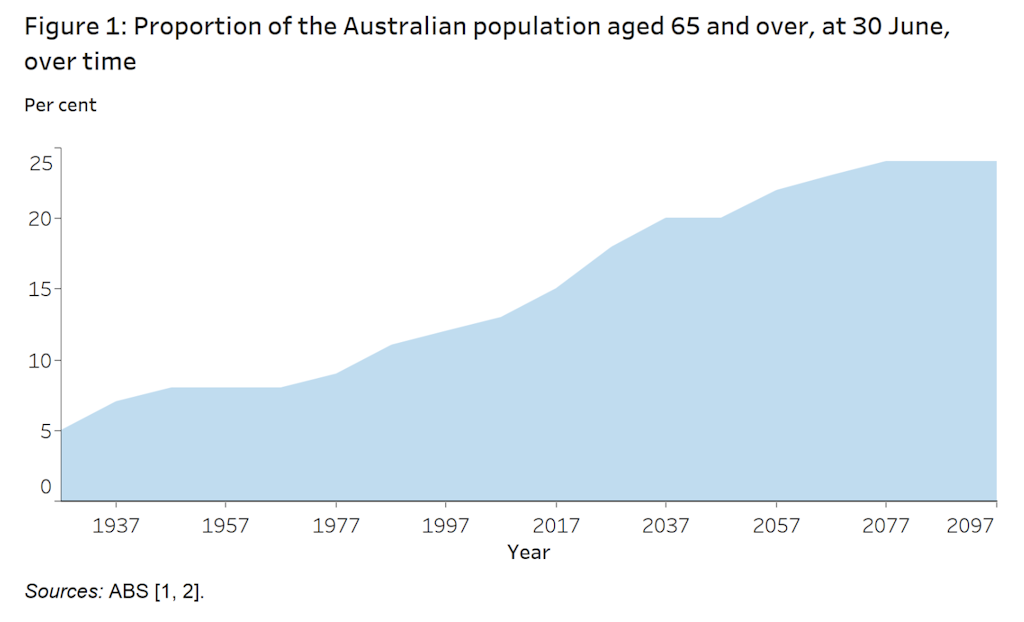The aged care tsunami has arrived, and digital innovations are here to help
OPINION PIECE – The baby boomer bubble is the aged care tsunami that is already upon us, dramatically altering the consumer make-up of the sector, both in terms of volume and expectations. In my view, this leaves traditional models of aged care in Australia as mostly redundant, but also offers the opportunity for new, innovative approaches in delivering care to our senior citizens.

Source: Getty Images – John Dominis / Contributor
In practical terms, where we used to have 40,000 Australians turning 65 each year, that number is now closer to 140,000; and this is a trend that is set to continue for the next 15 years.
With shifting generational expectations, many of these people will be looking to stay in their own home longer. Think about your own grandparents at 65 years of age and now think about your parents at that same age, or even imagine yourself at 65. There’s not only a big difference in mobility, independence, life expectations and overall wellbeing (in most cases anyway), but in one generation we have seen a significant change from traditionalists (1900 – 1945) who see sacrifice as a badge of honour, to boomers (1946 – 1964) who question everything and seek personal gratification. Boomers are acknowledged as revolutionary compared to their parents, and they are once again the catalyst for change when it comes to aged care.
With over 100,000 Australians currently waiting for approved home care packages, we are already seeing this seismic shift in consumer expectations bare its fruits and the system is buckling under the pressure. With only 14,000 additional Home Care packages announced in the last Federal Budget, for me, it is clear that government cannot continue to try and fund how care is delivered in its current form, especially with the shift in overall dependants (consumers) versus contributors (tax payers).

There have been a number of reviews into the sector in recent times that have provided recommendations that cover funding models, consumer centric driven competition and quality standards. While I agree that the sector needs fundamental reform, my hope is that the best practice model for delivering care is what the sector works towards. With proportionally more senior Australians preferring to stay at home for as long as practical, I expect this trend to continue where more care is delivered within the community. We need to understand how the differing care needs will interface, to complement rather than combat, ultimately to deliver a holistic approach rather than a siloed one.
But this approach will require innovative solutions, otherwise there will be a greater cost burden to deliver care in a perceived less efficient way. I have had personal experience where technology enabled clinicians to visit community-based patients in the most prioritised (based on urgency) and efficient (routing of staff across the whole of Australia) way, at an ongoing cost of less than a cup of coffee a day; and I was fortunate enough to have this work recognised across Australia & New Zealand.
However, similar practical innovations are not common place across aged care. A provider recently shared their frustration with me, saying they can currently get a staff member to an urgent in-home care event within 2 hours and this was considered best practice. Yet Domino’s can get a pizza to your door in less than 15 minutes, and it is still hot… Technology is not the reason for disruption, it simply enables it.
The challenge with the traditional models and thinking in aged care is that they were established in an environment very different to today; that is before the digital revolution that has changed the game in terms of connectivity and the speed of technology innovation. Therefore, it is important for those who will ultimately drive the sector forward to have a greater understanding of how the new digital environment can deliver effectiveness and efficiency previously not possible.
Rather than talk about the idea that disruption is coming – and then react when it happens – I believe it’s far better to place bets and try out new models providers believe in; test them and then implement. New technological innovations such as artificial intelligence, machine learning, and almost unlimited scale were once only available to those with the deepest pockets. However, these are now accessible to all, enabling a more cost-effective way to experiment than ever before, a systems design concept we call “fail-fast”.
With the private sector almost holding its breath, waiting for certainty before investing heavily again in the sector, the potential to incentivise innovative solutions could reignite the sector once again as long as the consumer needs and wants remain firmly the focus that the solutions are built upon.
To be able to care for our seniors now, and well into the future, we need to ditch the old thinking, adapt to a changing environment and discover new horizons.

Mark C Ogden BBsMn (Mktg/Ops), MBA (StratMn)
With over 20 years experience in global corporations and the technology sector, Mark has proven success in understanding then delivering high-value outcomes based on consumer behaviour. Mark has worked across the care, consumer, manufacturing, and technology industries, in senior business, sales and marketing roles. Mark has also represented Asia Pacific on global capability teams as well as been a key driver of innovation on some of the world’s most iconic brands.
Mark has a diverse background, with a philosophy of providing strong business value for customers in a continuously advancing world and is particularly focused on maximising DPS’ specialty in empowering consumers of care through informed choice and innovation.






















